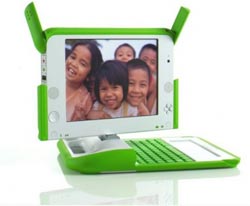Cheap laptops - Hope for poor children
The bright color laptop 2B1 The Children's Machine is likely to be recognized as one of the significant inventions of the 21st century.
The newly introduced Taiwanese product of Quanta shows it superior to the original requirements.
That would be a wi-fi networked laptop and connect between computers together. Its screen is even more than 95% of the laptop screens currently on the market: 1200x900 resolution on 7.5 inch screen, ie 200dpi. The manufacturer also addresses the explosion problem of current Li-Ion batteries when using rechargeable NiMH batteries.
 The machine does not use much electricity: the screen only consumes 0.2-1W, which is only 1/7 of the current computer and the whole machine only consumes an average of 2W, ie 1/10 of the average consumption of the machines available in the market. This is a significant change, suitable for remote areas without stable electricity systems.
The machine does not use much electricity: the screen only consumes 0.2-1W, which is only 1/7 of the current computer and the whole machine only consumes an average of 2W, ie 1/10 of the average consumption of the machines available in the market. This is a significant change, suitable for remote areas without stable electricity systems.
2B1 The Children's Machine is a specific product of a popular laptop not long ago in the ambitious program called OLPC (a laptop for every child). This program is funded by many major computer companies in the world with the aim of "helping every child in developing countries have access to information technology, access to a form new education ".
Organizers clearly announce the intention: computers will be researched for mass production at $ 100 / machine, enabling children in remote areas to access new knowledge (of course, the purchaser of the machine will supply Play for children will be government or charitable organizations).
The program has been received by many countries with a positive attitude. At first, Nigeria promised to order 1 million phones. Brazil, Argentina, China, Egypt and Thailand also made similar claims.
Even the Thai government has confirmed that it will choose the first 500 children to try to use the machine in October or November next. These optimistic signals make the manufacturer believe that when reaching an order of 6-10 million units, the possibility of a machine price of 100 USD / machine as originally intended is what will happen in 2008.
Currently, the price of the device is actually at US $ 140 per unit, but in return there are some new free integrated utilities on the device (open Linux operating system). In particular, the Wikimedia Foundation has just announced that it will recruit good materials from Wikipedia's "online dictionary" to transfer directly to each factory. Memory 512MB and 128MB of RAM are enough to help ensure the task of providing new materials to users.
Many believe that there will be a revolution in education in developing countries if the OLPC program is implemented in accordance with the original goal. However, there are countries like India who think they will use money to build classrooms and pay teachers' salaries rather than buying a laptop.
The Indian Ministry of Education also argues: why is this device for students aged 6-12 not introduced to children in developed countries?
 2,000 USD laptop: Many outstanding advantages
2,000 USD laptop: Many outstanding advantages Tips for optimizing your laptop's power source
Tips for optimizing your laptop's power source Laptop 500 USD
Laptop 500 USD Exhibition of laptops
Exhibition of laptops Top 5 companies holding 70% of global laptop market share in 2006
Top 5 companies holding 70% of global laptop market share in 2006 Turn laptops into mobile phones
Turn laptops into mobile phones